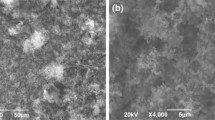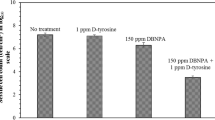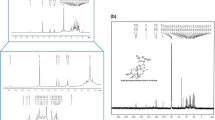Abstract
Trehalase can biocatalyze the conversion of trehalose to glucose. It is an enzyme that plays an important role in biofilm formation. Thus, trehalase has been patented as a chemical for preventing and treating biofilms. Sulfate-reducing bacteria (SRB) biofilms are often found responsible for biocorrosion, also known as microbiologically infuenced corrosion (MIC), especially in the oil and gas industries and in water utilities. The MIC treatment process typically requires biocide treatment of biofilms, sometimes together with scrubbing. Owing to environmental concerns, a lower biocide dosage is desired in the treatment process. In this work, trehalase was tested as a green biocide enhancer to enhance tetrakis hydroxymethyl phosphonium sulfate (THPS) in the prevention of Desulfovibrio vulgaris MIC of C1018 carbon steel in ATCC 1249 culture medium at 37 °C. THPS is one of the most popular industrial biocides owing to its broad-spectrum efficacy and green chemical status. After 7 days of incubation in 50 mL anaerobic vials containing 40 mL culture medium at pH 7.0, the sessile cell counts indicated that 50 ppm (w/w) THPS + 30 ppm (w/w) trehalase led to an extra 5.7-fold sessile cell reduction when compared with the 50 ppm THPS alone treatment. As a consequence, the combination treatment also resulted in an extra 54% in pit depth reduction and 30% in weight loss reduction when compared with the 50 ppm THPS alone treatment (with 9.0 μm and 1.0 mg/cm2). The biofilm images corroborated the decreased sessile cell count and pitting corrosion.







Similar content being viewed by others
References
Kahrilas GA, Blotevogel J, Stewart PS, Borch T (2015) Biocides in hydraulic fracturing fluids: a critical review of their usage, mobility, degradation, and toxicity. Environ Sci Technol 49:16–32. https://doi.org/10.1021/es503724k
Wang D, Liu J, Jia R et al (2020) Distinguishing two different microbiologically influenced corrosion (MIC) mechanisms using an electron mediator and hydrogen evolution detection. Corros Sci 177:108993. https://doi.org/10.1016/j.corsci.2020.108993
Lekbach Y, Dong Y, Li Z et al (2019) Catechin hydrate as an eco-friendly biocorrosion inhibitor for 304L stainless steel with dual-action antibacterial properties against Pseudomonas aeruginosa biofilm. Corros Sci 157:98–108. https://doi.org/10.1016/j.corsci.2019.05.021
Enning D, Venzlaff H, Garrelfs J et al (2012) Marine sulfate-reducing bacteria cause serious corrosion of iron under electroconductive biogenic mineral crust. Environ Microbiol 14:1772–1787. https://doi.org/10.1111/j.1462-2920.2012.02778.x
Skovhus TL, Eckert RB, Rodrigues E (2017) Management and control of microbiologically influenced corrosion (MIC) in the oil and gas industry—overview and a North Sea case study. J Biotechnol 256:31–45. https://doi.org/10.1016/j.jbiotec.2017.07.003
Wang D, Kijkla P, Mohamed ME et al (2021) Aggressive corrosion of carbon steel by Desulfovibrio ferrophilus IS5 biofilm was further accelerated by riboflavin. Bioelectrochemistry 142:107920. https://doi.org/10.1016/j.bioelechem.2021.107920
Ayangbenro AS, Olanrewaju OS, Babalola OO (2018) Sulfate-reducing bacteria as an effective tool for sustainable acid mine bioremediation. Front Microbiol 9:1986. https://doi.org/10.3389/fmicb.2018.01986
Rasheed PA, Jabbar KA, Rasool K et al (2019) Controlling the biocorrosion of sulfate-reducing bacteria (SRB) on carbon steel using ZnO/chitosan nanocomposite as an eco-friendly biocide. Corros Sci 148:397–406. https://doi.org/10.1016/j.corsci.2018.12.028
Wang D, Ramadan M, Kumseranee S et al (2020) Mitigating microbiologically influenced corrosion of an oilfield biofilm consortium on carbon steel in enriched hydrotest fluid using 2,2-dibromo-3-nitrilopropionamide (DBNPA) enhanced by a 14-mer peptide. J Mater Sci Technol 57:146–152. https://doi.org/10.1016/j.jmst.2020.02.087
Li Y, Jia R, Al-Mahamedh HH et al (2016) Enhanced biocide mitigation of field biofilm consortia by a mixture of D-amino acids. Front Microbiol 7:896. https://doi.org/10.3389/fmicb.2016.00896
Mah T-FC, O’Toole GA (2001) Mechanisms of biofilm resistance to antimicrobial agents. Trends Microbiol 9:34–39. https://doi.org/10.1016/S0966-842X(00)01913-2
Tang H-Y, Yang C, Ueki T et al (2021) Stainless steel corrosion via direct iron-to-microbe electron transfer by Geobacter species. ISME J 15:3084–3093. https://doi.org/10.1038/s41396-021-00990-2
Sharma M, Liu H, Chen S et al (2018) Effect of selected biocides on microbiologically influenced corrosion caused by Desulfovibrio ferrophilus IS5. Sci Rep 8:16620. https://doi.org/10.1038/s41598-018-34789-7
Scarascia G, Lehmann R, Machuca LL et al (2019) Effect of quorum sensing on the ability of Desulfovibrio vulgaris to form biofilms and to biocorrode carbon steel in saline conditions. Appl Environ Microbiol 86:e01664-e1719. https://doi.org/10.1128/AEM.01664-19
Tripathi AK, Thakur P, Saxena P et al (2021) Gene sets and mechanisms of sulfate-reducing bacteria biofilm formation and quorum sensing with impact on corrosion. Front Microbiol 12:3120. https://doi.org/10.3389/fmicb.2021.754140
Okoro CC, Samuel O, Lin J (2016) The effects of tetrakis-hydroxymethyl phosphonium sulfate (THPS), nitrite and sodium chloride on methanogenesis and corrosion rates by methanogen populations of corroded pipelines. Corros Sci 112:507–516. https://doi.org/10.1016/j.corsci.2016.08.018
Sharma M, Menon P, Voordouw J et al (2018) Effect of long term application of tetrakis(hydroxymethyl)phosphonium sulfate (THPS) in a light oil-producing oilfield. Biofouling 34:605–617. https://doi.org/10.1080/08927014.2018.1476500
Gieg LM, Jack TR, Foght JM (2011) Biological souring and mitigation in oil reservoirs. Appl Microbiol Biotechnol 92:263–282. https://doi.org/10.1007/s00253-011-3542-6
Lam H, Oh D-C, Cava F et al (2009) D-amino acids govern stationary phase cell wall remodeling in bacteria. Science 325:1552–1555. https://doi.org/10.1126/science.1178123
Kolodkin-Gal I, Romero D, Cao S et al (2010) D-amino acids trigger biofilm disassembly. Science 328:627–629. https://doi.org/10.1126/science.1188628
Jia R, Yang D, Dou W et al (2019) A sea anemone-inspired small synthetic peptide at sub-ppm concentrations enhanced biofilm mitigation. Int Biodeterior Biodegrad 139:78–85. https://doi.org/10.1016/j.ibiod.2018.11.009
Aliashkevich A, Alvarez L, Cava F (2018) New insights into the mechanisms and biological roles of D-amino acids in complex eco-systems. Front Microbiol 9:683. https://doi.org/10.3389/fmicb.2018.00683
Jia R, Li Y, Al-Mahamedh HH, Gu T (2017) Enhanced biocide treatments with D-amino acid mixtures against a biofilm consortium from a water cooling tower. Front Microbiol 8:1538. https://doi.org/10.3389/fmicb.2017.01538
Davis DW, Arenz BW, Connellan TK, Ivanova SA (2017) Compositions and methods to prevent and treat biofilms. EU Patent No. 2,717,926 B1
Sakaguchi M (2020) Diverse and common features of trehalases and their contributions to microbial trehalose metabolism. Appl Microbiol Biotechnol 104:1837–1847. https://doi.org/10.1007/s00253-019-10339-7
Zheng Z, Xu Y, Sun Y et al (2015) Biocatalytic production of trehalose from maltose by using whole cells of permeabilized recombinant Escherichia coli. PLoS ONE 10:e0140477. https://doi.org/10.1371/journal.pone.0140477
Sakaguchi M, Mukaeda H, Kume A et al (2021) Evaluation of the roles of hydrophobic residues in the N-terminal region of archaeal trehalase in its folding. Appl Microbiol Biotechnol 105:3181–3194. https://doi.org/10.1007/s00253-021-11237-7
Ivanova SA, Davis DW, Arenz BW, Connellan TK (2019) Compositions and methods to prevent and treat biofilms. US Patent No. 10,420,822 B2
Ivanova SA, Davis DW, Arenz BW, Connellan TK (2020) Compositions and methods to prevent and treat biofilms. US Patent No. 10,758,596 B2
Elbein AD, Pan YT, Pastuszak I, Carroll D (2003) New insights on trehalose: a multifunctional molecule. Glycobiology 13:17R-27R. https://doi.org/10.1093/glycob/cwg047
Pinto RV, Gomes PS, Fernandes MH et al (2020) Glutaraldehyde-crosslinking chitosan scaffolds reinforced with calcium phosphate spray-dried granules for bone tissue applications. Mater Sci Eng C 109:110557. https://doi.org/10.1016/j.msec.2019.110557
Posati T, Listwan A, Sotgiu G et al (2020) Keratin/Hydrotalcites hybrid sponges as promising adsorbents for cationic and anionic dyes. Front Bioeng Biotechnol 8:68. https://doi.org/10.3389/fbioe.2020.00068
Jia R, Wang D, Jin P et al (2019) Effects of ferrous ion concentration on microbiologically influenced corrosion of carbon steel by sulfate reducing bacterium Desulfovibrio vulgaris. Corros Sci 153:127–137. https://doi.org/10.1016/j.corsci.2019.03.038
Jia R, Tan JL, Jin P et al (2018) Effects of biogenic H2S on the microbiologically influenced corrosion of C1018 carbon steel by sulfate reducing Desulfovibrio vulgaris biofilm. Corros Sci 130:1–11. https://doi.org/10.1016/j.corsci.2017.10.023
Dou W, Jia R, Jin P et al (2018) Investigation of the mechanism and characteristics of copper corrosion by sulfate reducing bacteria. Corros Sci 144:237–248. https://doi.org/10.1016/j.corsci.2018.08.055
Wang D, Unsal T, Kumseranee S et al (2021) Sulfate reducing bacterium Desulfovibrio vulgaris caused severe microbiologically influenced corrosion of zinc and galvanized steel. Int Biodeterior Biodegrad 157:105160. https://doi.org/10.1016/j.ibiod.2020.105160
Schroettner H, Schmied M, Scherer S (2006) Comparison of 3D surface reconstruction data from certified depth standards obtained by SEM and an infinite focus measurement machine (IFM). Microchim Acta 155:279–284. https://doi.org/10.1007/s00604-006-0556-3
Acknowledgements
This work was financially supported by SP Global, Inc., Chantilly, VA 20151, USA.
Author information
Authors and Affiliations
Corresponding author
Ethics declarations
Conflict of interest
The authors declare that they have no conflict of interest.
Additional information
Publisher's Note
Springer Nature remains neutral with regard to jurisdictional claims in published maps and institutional affiliations.
Supplementary Information
Below is the link to the electronic supplementary material.
Rights and permissions
About this article
Cite this article
Wang, D., Ivanova, S.A., Hahn, R. et al. Evaluation of trehalase as an enhancer for a green biocide in the mitigation of Desulfovibrio vulgaris biocorrosion of carbon steel. Bioprocess Biosyst Eng 45, 659–667 (2022). https://doi.org/10.1007/s00449-021-02684-7
Received:
Accepted:
Published:
Issue Date:
DOI: https://doi.org/10.1007/s00449-021-02684-7




